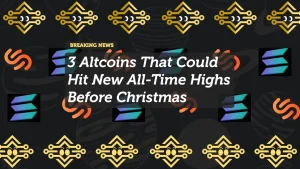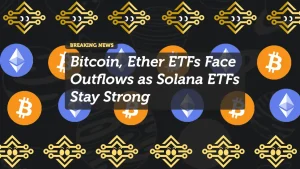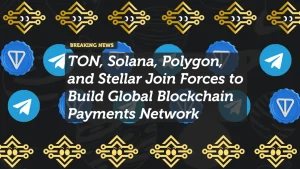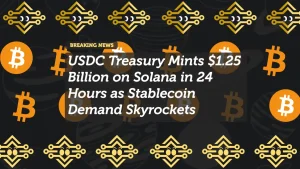
DeFi Developments: TVL Growth Fueled by Solana, Base, and Aptos Ecosystem Expansion
The decentralized finance (DeFi) ecosystem continues to expand, with Total Value Locked (TVL) across platforms showing a slight but meaningful increase. This growth is being driven by exciting developments within the Solana, Base, and Aptos ecosystems, as well as the launch of innovative new protocols that are attracting users and capital.
From enhanced scalability to new use cases, these ecosystems are redefining what’s possible in DeFi. Let’s take a closer look at the factors fueling the latest TVL growth and what they mean for the future of decentralized finance.
What is TVL and Why Does It Matter?
Total Value Locked (TVL) represents the total amount of assets deposited in DeFi protocols, such as lending platforms, decentralized exchanges (DEXs), and staking pools. TVL serves as a key metric to gauge the health and adoption of DeFi ecosystems.
A rise in TVL often indicates:
- Increased trust and user participation in DeFi platforms.
- Growing adoption of specific blockchains or protocols.
- A healthy inflow of liquidity, which is crucial for the functioning of decentralized applications (dApps).
In recent weeks, TVL across DeFi platforms has seen a modest uptick, signaling renewed investor interest and ecosystem expansion, particularly on networks like Solana, Base, and Aptos.
Solana’s DeFi Revival: Low Fees and High Performance
Despite past challenges, Solana is proving its resilience as it spearheads DeFi TVL growth. Its low transaction fees and high throughput make it an attractive choice for developers and users alike.
Key Drivers of Solana’s Growth:
- New Protocol Launches:
Recent additions like Cypher Protocol (a decentralized trading platform) and Mango Markets have brought more liquidity and users to Solana’s DeFi ecosystem. - NFT Integration:
Solana’s strong presence in the NFT market has helped bridge DeFi and NFTs, introducing new DeFi use cases such as lending against NFTs. - Institutional Interest:
With institutional-grade infrastructure and scalability, Solana is seeing more capital inflows, further boosting TVL.
TVL Impact:
Solana’s TVL has grown by 4-6% in recent weeks, reflecting the positive momentum in its ecosystem.
Base Blockchain: Coinbase’s Layer-2 Scaling Solution
Base, a layer-2 blockchain launched by Coinbase, has quickly become a key player in the DeFi space. By leveraging Ethereum’s security and scalability improvements from Optimistic Rollups, Base has positioned itself as a hub for DeFi innovation.
Key Factors Driving Base’s Growth:
- Developer-Friendly Ecosystem:
Base offers seamless integration with Coinbase’s tools and services, making it easier for developers to launch DeFi projects. - DeFi Onboarding:
As a Coinbase product, Base benefits from the exchange’s massive user base, which has helped onboard new DeFi users. - Prominent Protocols:
Projects like Uniswap and Aave have expanded to Base, bringing significant liquidity and user activity to the network.
TVL Impact:
Base has seen a 10% increase in TVL, driven by its unique position as a layer-2 solution tied to a trusted exchange.
Aptos: The New Frontier for DeFi Innovation
Aptos, often called the “Solana killer,” is emerging as a top contender in the DeFi space thanks to its unique consensus mechanism and focus on scalability.
Why Aptos is Attracting Attention:
- Parallel Execution:
Aptos uses a parallel execution model, which processes multiple transactions simultaneously, reducing latency and improving throughput. - Rapid Ecosystem Growth:
New protocols like Pontem Network (a DeFi hub) and LiquidSwap (a decentralized exchange) are boosting activity on the platform. - Partnerships and Incentives:
Aptos has launched incentive programs to attract developers, creating a vibrant ecosystem of dApps and protocols.
TVL Impact:
Aptos has seen a 7% rise in TVL, underscoring its potential as a scalable DeFi ecosystem.
Emerging Trends in DeFi: New Projects and Protocols
The growth in TVL is not just about established players like Solana, Base, and Aptos—it’s also driven by innovative new projects that are expanding the possibilities of decentralized finance.
Key Trends Driving New Growth:
- Cross-Chain Compatibility:
Protocols that enable interoperability between blockchains are gaining traction, allowing users to move assets seamlessly across ecosystems. - Real-World Asset Tokenization:
DeFi platforms are increasingly tokenizing real-world assets like real estate and bonds, unlocking new use cases for decentralized finance. - AI Integration:
Projects combining AI with DeFi are emerging, offering automated portfolio management and risk assessment tools to enhance user experience. - Decentralized Stablecoins:
The rise of algorithmic and decentralized stablecoins is creating new opportunities for yield generation and liquidity provision in DeFi.
What Does This Mean for the Future of DeFi?
The slight increase in TVL is a positive sign for the DeFi space, indicating growing interest and participation. However, this growth is not evenly distributed—ecosystems like Solana, Base, and Aptos are leading the way, showcasing the importance of innovation and user-friendly platforms.
Key Takeaways:
- Ecosystem Differentiation Matters: Blockchains that offer unique advantages, such as scalability or user incentives, are better positioned to attract capital and users.
- Regulatory Clarity is Crucial: As the DeFi space grows, clear regulatory frameworks will be essential to ensure long-term sustainability and institutional participation.
- Focus on Usability: Projects that prioritize user experience and education will be more successful in onboarding new participants to DeFi.
As the DeFi market evolves, we can expect continued growth in TVL driven by technological advancements and the expansion of blockchain ecosystems.
In Summary
The slight increase in DeFi TVL reflects a growing confidence in decentralized finance, fueled by the rise of ecosystems like Solana, Base, and Aptos. With new projects driving innovation and adoption, the future of DeFi looks bright, though challenges like scalability and regulation remain.
Key Highlights:
- Solana: Boosted by low fees and NFT-DeFi integration.
- Base: Leveraging Coinbase’s user base and developer-friendly tools.
- Aptos: Gaining traction with parallel execution and incentives for developers.
The next phase of DeFi growth will likely depend on continued innovation, cross-chain interoperability, and the integration of real-world assets into blockchain ecosystems.
FAQs
1. What is TVL in DeFi?
TVL, or Total Value Locked, represents the total amount of assets deposited in DeFi protocols like lending platforms, DEXs, and staking pools.
2. Why is Solana seeing a TVL increase?
Solana’s high throughput, low fees, and growing ecosystem of protocols and NFTs are driving its recent TVL growth.
3. What makes Base unique in DeFi?
Base, launched by Coinbase, offers seamless integration with the exchange’s tools and user base, attracting developers and liquidity to its layer-2 blockchain.
4. Why is Aptos gaining attention in DeFi?
Aptos uses parallel execution to improve scalability and has introduced new DeFi protocols, making it a promising ecosystem for growth.
















